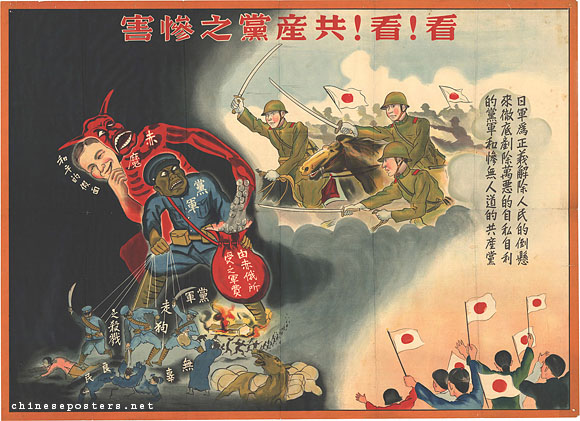
In the beginning, woman was truly the sun. An authentic person. Now she is the moon, a wan and sickly moon, dependent on another, reflecting another’s brilliance.
Seitô herewith announces its birth.

Anti-Communist Poster with Japanese as Heroes c. 1938 (from Wikipedia)
The ideals of peace and democracy could not be separated easily. The reverse course, initiated by the occupation and taken up with gusto by a succession of conservative governments, entailed Japan’s remilitarization both literally and economically. Only one month after the beginning of the Korean War, Prime Minister Yoshida inaugurated a modestly named National Police Reserve (Kokka Keisatsu Yobitai), a 75,000-strong force trained by U.S. advisors and armed with U.S. weaponry, including M1 rifles, machine guns, mortars, bazookas, flame throwers, artillery, and tanks (known as “special vehicles”).
The Korean War also rekindled Japan’s military industrial capacity. The economic windfall brought about by “special procurement” contracts with the U.S. gave such a critical boost to Japan’s languishing economy that Yoshida and other conservatives referred to the war as a “gift from the gods.” The sudden rise in the demand for military goods reanimated Japan’s factories and economic structures and fostered closer relations between the government and large industries.
The End of Postwar Democracy?
The role of "Special Procurements"
National Police Reserves - apparently Gen. MacArthur ordered Japanese officials to do this and they were only too happy to oblige - In Yoshitake's eyes everything that constituted the postwar ideal of peace and democracy was being cast aside.
The Japanese government had received directives from base officials to evict 140 families in Sunagawa from their homes and farmland to make way for the runway. For the farmers, it was not simply a problem of negotiating fair payment from the Procurement Office for the land they were going to lose. The loss of land would be an abrupt loss of livelihood not to mentioin ancestral and local history. Many locals traced their family ties in Sunagawa back to the early Edo Period.
Historian Shoji Arakawa wrote that “As a result of the intense anti-base movement of the Sunagawa Struggle —synergized with the political conflict and public division over the revision of the security treaty — the security treaty itself became a point of contention in the courts, through which the role, significance and interpretation of Article 9 had to be probed.” Without the farmers of Sunagawa, the Anpo (Japan-U.S. security treaty) protests of 1960 would have been something else entirely.
In 1958, the U.S. formally transferred control of the Fuji maneuver areas back to Japan, and in 1959, the bulk of U.S. troops in the Fuji region were relocated to Okinawa. Japan’s Self-Defense Forces (SDF)—thus called because the new constitution written by the U.S. Occupation authorities forbade Japan from going to war—took over regular management of the maneuver areas, with the U.S. military continuing to use them intermittently. Given the new balance of power, local iriai groups (i.s. groups committed to the long-held beliefs that rights to common lands belonged to local farmers) stepped up pressure on the Japanese government, arguing that SDF occupation of the maneuver areas was illegitimate unless the military entered into formal long-term contracts. Because much of their commons was registered as private property, communities near the East Maneuver Area had enough leverage to negotiate relatively quickly a 10-year rental agreement with the SDF in 1959.
The North Maneuver Area, consisting of lands mainly registered in the name of Yamanashi prefecture or the state, was a different story.
Throughout the 1960s the Japanese military reached temporary deals with iriai rights-holders, but conflict was ongoing, and sometimes erupted in dramatic protests. The most high-profile demonstration took place in 1965, when local iriai groups dissatisfied with payments offered by the government built protest huts in the North Fuji Maneuver Area and effectively brought SDF artillery practice to a halt for the entire summer.
The standoff intensified in early October, when a U.S. artillery regiment decided to fire “Little John” rockets from the East Maneuver Area to the North Maneuver Area. Police tried to clear the impact zone of protestors, but they were unsuccessful, and the commander of the artillery regiment refused to back down. In the end, the rocket test went forward; luckily no one was injured. This incident quickly became a national focal point for left-wing activists.
Highlighting the fact that the Little John rockets could potentially carry nuclear payloads, they tried to turn what was basically a conflict over common land rights into a central front of their ideological battle againstthe U.S.-Japan Security Treaty.
|
Women entered the peace movement in large numbers in response to an incident that occurred in 1954. In March of that year a Japanese tuna fishing vessel named the Lucky Dragon #5 was caught in the radioactive fallout from a U.S. hydrogen bomb test in the Pacific, resulting in the death of one crew member from radiation sickness. News that the ship’s cargo had been distributed to markets around Japan created a scare about the safety of the food supply, and six U.S. bomb tests over the subsequent two-and-a-half months kept the fear alive.The incident was sometimes referred to as Japan’s third nuclear bombing, and brought Japan’s continuing exposure to the gathering nuclear arms race to public consciousness. It sparked signature campaigns demanding a ban on nuclear weapons that began at the local level, led primarily by housewives who stood at their local markets or used connections with the PTA and local governments to circulate petitions. |